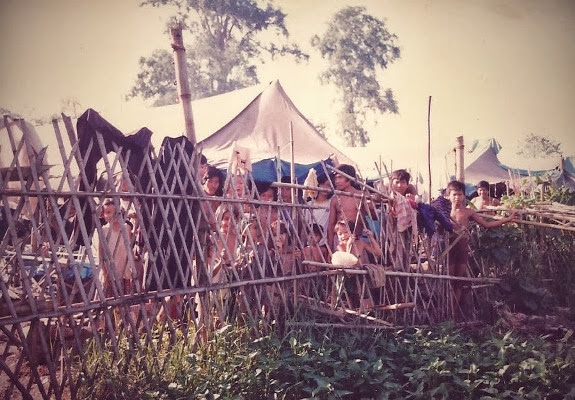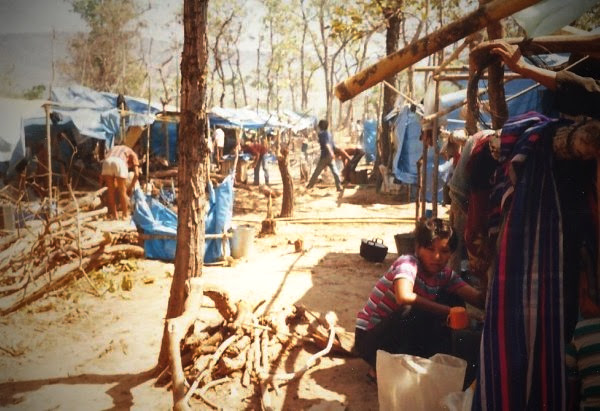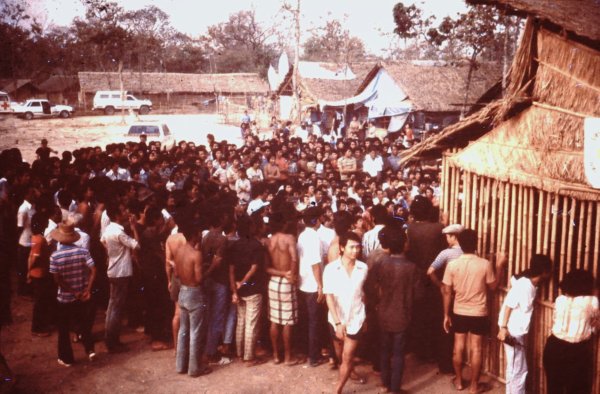Fear, Uncertainty Mark Refugees' Lives on Thai Border
By William Branigin April 23, 1983
" the 147 Vietnamese from Phnom Chat were lucky to have made it to the Red Hill camp at all without any loss of life. "
For 23,000 Cambodians who streamed across the Thai-Cambodian border three weeks ago to escape a Vietnamese attack on their refugee settlement, home is now a parched expanse of dusty scrub land known to relief workers as "Red Hill" near this Thai border village.
Food and water are provided by the U.N. Border Relief Organization. Otherwise, the refugees have only what they were able to carry with them on the six-mile trek from their camp at Phnom Chat. There is little activity amid the choking red dust and the stifling heat.
The only protection from the blazing sun comes from blue plastic sheets distributed by U.N. agencies and stretched across wooden poles to form makeshift shelters. There is no protection from the occasional Vietnamese artillery shells that have landed in the area since the refugees fled their Khmer Rouge-controlled camp on March 31.
Even more precarious is the existence of a minority within the camp: 147 Vietnamese who had been stuck at Phnom Chat since fleeing their homeland and making their way across Cambodia to the Thai border. Barred from refugee camps in Thailand under the Bangkok government's "humane deterrence" policy to discourage new refugee arrivals, these Vietnamese "land people" fear they will eventually be sent back across the border and will face the Cambodians' vengeance for the attack by Hanoi's troops.
"When we were at Phnom Chat the Khmer people always threatened us," said Pham Dinh Dai, a 29-year-old leader of the Vietnamese group. "They wanted to kill us. They treated us very badly. Some women were raped, and some persons were beaten."
"Now we are afraid we must return to Phnom Chat," he added. "If we return there we can be killed by the Khmers in revenge, although we are very different from the Hanoi Communists."
Similar fears were expressed by Nguyen Duc Chan, a 35-year-old doctor from Ho Chi Minh City (formerly Saigon) who said he arrived at the border five months ago. He said he fled to seek entry into the United States, where he has two brothers living in Washington, D.C., and one in Nebraska.
According to Pham Dinh Dai, the Vietnamese are frequently threatened at the Red Hill camp, where they live in a specially designated section. A team of 20 Thai soldiers comes every night to protect them from the Cambodians, he said.
He said the Vietnamese hope to be allowed to stay in Thailand to await resettlement abroad. But they and about 550 elsewhere on the border were not covered by a Thai decision earlier this year to relax the deterrence policy and allow nearly 1,900 Vietnamese land people to be processed for emigration.
Under the circumstances, western relief officials said, the 147 Vietnamese from Phnom Chat were lucky to have made it to the Red Hill camp at all without any loss of life.
According to Pham Dinh Dai, the Communist Khmer Rouge authorities at Phnom Chat "allowed us to run away with the Khmer people" when the Vietnamese troops attacked.
The Vietnamese refugees offered views of the fighting that differed markedly from the accounts of the Khmer Rouge, who ruled Cambodia brutally for nearly four years before the invading Vietnamese troops drove them from power.
According to one refugee, "some of the Khmer Rouge fighters stayed behind" at Phnom Chat, "but many ran away" with the civilians. "After they arrived here, the Khmer authorities appealed to them to go back to Phnom Chat and fight. Three truckloads went back on April 2. But many did not want to return."
Other refugees said scores of Cambodians were killed and wounded during the Vietnamese onslaught and while fleeing the camp. They said they came under heavy Vietnamese shelling even as they trekked inside Thailand.
For the 23,000 Cambodian civilians at Red Hill, there is little reason to think life will get much better. Many have been displaced numerous times since the Khmer Rouge took power in 1975 and since the Vietnamese ousted them in 1979.
"Where are they trudging to is really the question," said one relief official. "Every place has proved to be a transit stop."
He summed up the mood of the Cambodians here as one of "incredible resignation" to the continuing disastrous swirl of events affecting them "but no glimmer of hope that I can detect."
--------------------------------------------
 |
| Red Hill- Easter Day April 3, 1983 |
The story behind this photo:
March
31, 1983 the PAVN (People Army of Viet-Nam, or bộ đội) attacked and
overran Phnom-Chat camp, all Cambodian and Vietnamese refugees evacuated
to the Thailand border and set up camp next to the anti-tank ditch,
since Thai soldiers prevented the refugees from going into Thailand.
ICRC setup a clinic inside a big white tent right at the border to treat
the sick and the wounded. The next day when the PAVN started shelling the anti-tank ditch, refugees were allowed to flee deeper into Thailand, to a
campsite called Red-Hill. The ICRC clinic tent was left behind during the
evacuation. When ICRC wanted to retrieve the tent from the border to set
it up at Red-Hill, a group of Vietnamese refugees from Phnom-Chat
volunteered to go back to the border and fetched it under the threat of
PAVN attack, now that they controlled the area around the border.
The
Vietnamese rode to the border on the back of the pick-up truck seen in the back ground, quickly took apart the tent and brought it back to Red-Hill. All the ICRC nurses and volunteers gathered to celebrate the successful mission.
This photo was taken then.























 Monday, July 31, 2023
Monday, July 31, 2023
